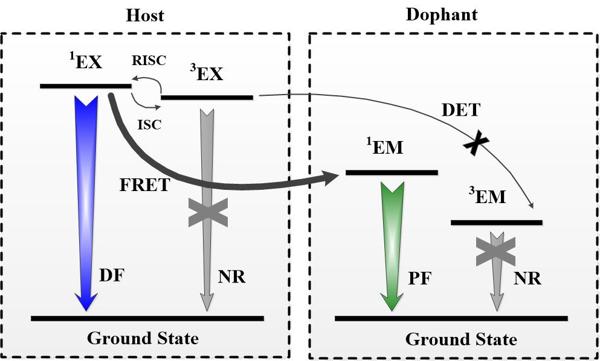Two-photon excited fluorescence (TPEF) materials can be excited by a near-infrared laser and emit in the visible light band. In view of their high three-dimensional spatial selectivity and superior imaging penetration depth, TPEF materials and technology have charming application prospect in fields of life sciences and medicine.
TPEF materials require both excellent two-photon absorption (TPA) and fluorescence properties. For most materials, TPA coefficient is much smaller than that of one-photon absorption. Therefore, great efforts have been devoted to the improvement of TPA coefficient. However, conventional strategies, such as increasing the molecular length and structural complexity, commonly brought about undesired decrease in fluorescence quantum efficiency. Therefore, it is urgent to find a new approach to high-performance TPEF materials with both large TPA coefficient and high fluorescence efficiency.
Exciplex-based thermally activated delayed fluorescence (TADF) emitter is an emerging material with extremely high quantum efficiency, and has been widely used in the field of organic light-emitting diodes (OLEDs). By minimizing the energy difference ΔEST between singlet state (S1) and triplet state (T1), exciplex-based TADF materials can transform non-radiative triplets to radiative singlets via reverse intersystem crossing (RISC) process.
The research group led by Prof. Zhiyong Pang from Shandong University, together with their collaborator Prof. Chuang Zhang at Institute of Chemistry, Chinese Academy of Sciences, proposed a new scheme for the design of TPEF materials based on exciplex TADF. By combining the excited state processes, including TPA, exciplex formation, RISC and Förster energy transfer (FRET), highly efficient color-adjustable TPEF was observed in exciplex-based TADF material for the first time. The achievements were recently published in Photonics Research, Volume 9, Issue 5, 2021 (Zhen Chen, Qian Zhou, Huitian Du, et al. Immensely enhanced color-adjustable upconversion fluorescence in electron donor-acceptor exciplex chromophores doped with fluorescent emitters.)
This work reveals not only the incorporation of TPA process in the donor and acceptor molecules with π delocalized electrons, but also the enhancement of TPEF through the TADF process of exciplex. In addition, the FRET process from the exciplex host to the fluorescent guest further benefits the TPEF.
This work compares the TPEF intensities from D-only, A-only, and D-A mixture samples under exactly the same excitation conditions, and it is found that the TPEF of the exciplex is increased by about 129% and 365% compared with D and A molecules, respectively.
In comparison with the undoped exciplex, the maximum photoluminescence quantum yield (PLQY) reaches about 98.65%, and consequently the TPEF of the doped exciplex is greatly enhanced. Based on the doped exciplex system (as shown in Figure 1), Pang et al. has successfully achieved the modulation and enhancement of TPEF at the same time, which is considered to be helpful in overcoming the current limitations of low-efficiency TPA and non-radiative excited state generation faced by TPEF materials. These findings would facilitate the design and synthesis of exciplex materials in the field of TPEF applications.
This work illustrates the role of exciplex host-guest doping system in balancing the efficiencies of TPA and fluorescence towards high-performance TPFE. By investigating the phenomenon of TPEF enhancement, the researchers also discovered a new TPA gain mechanism related to the intermolecular CT interaction in the D-A exciplex system.
Future works will be done on the exploration of TPEF process in exciplex materials, and biocompatible exciplex nanoparticles will be prepared as a potential contrast agent in the field of two-photon fluorescence imaging.

Figure 1. Schematic diagram of TPEF enhancement in the exciplex host-guest doping system.


